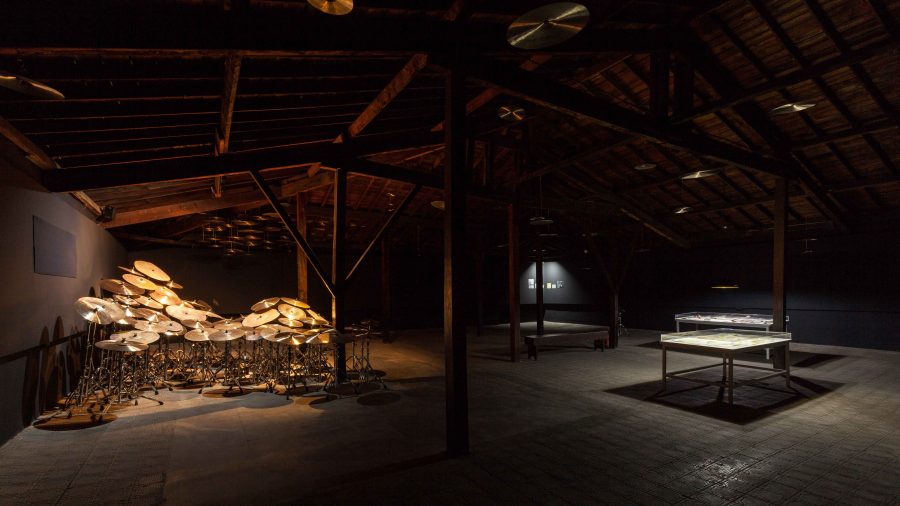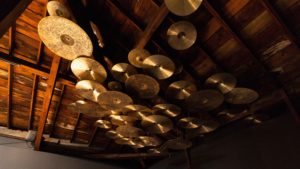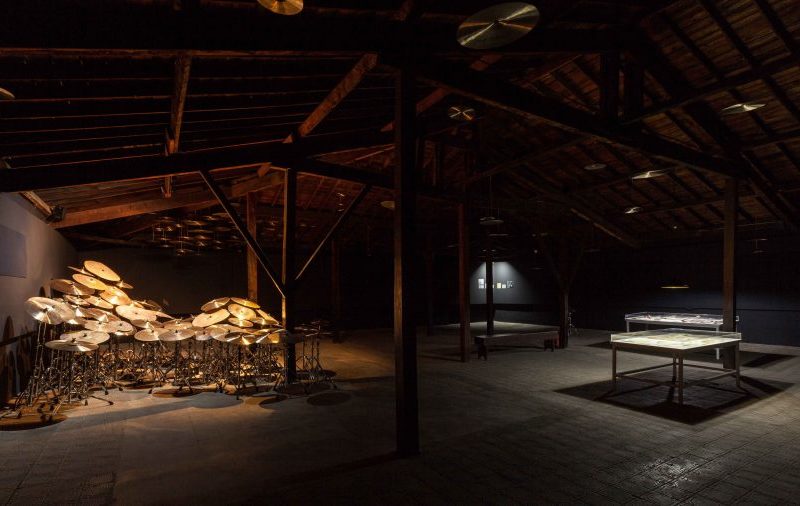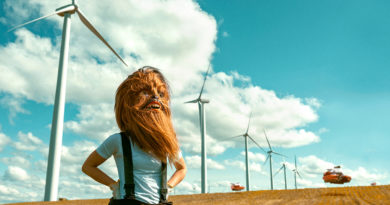Two artists and two questions: 14th Istanbul Biennial
The theme of “Salt Water” for the 14th Istanbul Biennial has become loaded with the signification of Syrian refugee crisis, especially over the past couple of months. Two contributing artists of the event,Adrián Villar Rojas ve Andrew Yang, whose works have been on show, answered our two questions regarding the crisis and their work in Biennial.
Interview by Yetkin Nural, Ekin Sanaç, Photo by Sahir Uğur Eren
Adrián Villar Rojas answers:
The very process of creating the sculptures with all the materials is very much the heart of the kind of work you do. Can you evaluate some of the direct and indirect symbolic meanings that determine the material choices and the production process of “The Most Beautiful Of All Mothers”?
The production process of “The Most Beautiful Of All Mothers” was very much alike to other previous ones in which I and my team set ourselves to a hard process of engagement with the chosen site, namely, the exhibitory space, the city, the region and even the country we are operating in, through a sustained residence period. In this regard, the extraordinary difference between this project for the 2015 Istanbul Biennial and all of the previous ones was the dominating presence of the sea: the decision to make use of the sea and the seashore as a plinth on which the pieces would be installed. This fact, this decision, implied such a high level of interaction with the island’s vernacular elements (sea water, sand, jelly fish, climate, weather, etc.) that this interaction turned into the overpowering variable of the project system. It is physically and emotionally striking to swim in the sea touching jelly fish everywhere to go from one piece to the next one. It was an overwhelming experience in which I tasted the innocent cruelty of planet Earth. Regarding the materials, I have always been interested in its entropic dynamics, in the way they change permanently turning the pieces into mutants whose shape, texture, consistency, smell, color, etc., never stop redefining themselves through the action of time. In this sense, we have developed the category of ‘diachronic object’ to capture this permanent sculpting task carried out by time long after we finish our own.
The title and the context of 14th Istanbul Biennale, “Salt Water”, has also come to signify a political issue that is a global and visible human tragedy, especially in the last few months. The refugees trying to escape the war in Syria have been forced to risk their lives on a journey on Mediterranean waters to safety and freedom. The refugee crisis have created a shift in our perception of what salt water means for the unfortunate victims of war. Do you think this recently highlighted global issue creates a need and/or an chance for a reactionary response from the Biennale and the contributing artists? If so, what kind of possibilities do you see?
When a project is finished and begins its interaction with the world, it takes its own roads as well as a child becomes a youth and then an adult. She or he makes her or his own decisions and opens her or his life to new people, perceptions, ideas, meanings, tastes, loves. We never know what paths, what kind of life our daughter or son will follow, we just make our best to give them what we think are the best tools and instruments to sail the seas of the Earth and of their own existence. We cannot design or pre-determine her or his journey, and when someone tries to do it, when some crazy parents – or even some crazy society – try to structure rigidly the lives of their daughters and sons, the most primitive instincts usually burst out against repression and authoritarianism. Therefore, in some way or other, – as a sort of father of my projects – I cannot be prouder of them as when they begin to live their own lives freely, meaning things I never meant, giving material expression to thoughts of others who find in them surfaces to slip their own mind processes. If this did not happen, something would no doubt be failing, because art is not a code with some programmed meaning that is already there to be decoded, but a complex and mysterious system of symbols whose ‘meanings’ – if any at all – are in the future, not in the past, and whose ‘implicit’ ideas must be created by the world – by the viewers -, not interpreted by an exegete.
In Istanbul I took my risks, I made my bet, the field of action was really strong, the system of symbols pre-existing the project was extraordinarily dense, full of layers and folds. Turkey itself is going through socio-political and economic changes that are re-defining its future, and this is precisely why I decided to face this project. I never do what I want but what the site deserves, what the site is silently asking for. My bet was to serve as a bridge, as a communicating channel between all these symbols. My bet was to understand that Turkey, Trotsky and the sea had to be re-articulated and re-channeled by a close and at the same time distant point of view. What happens afterwards is the world creating and re-creating meaning on the basis of their own needs and fantasies.
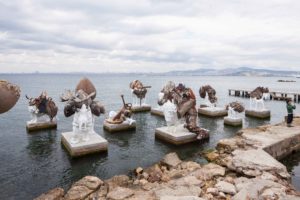
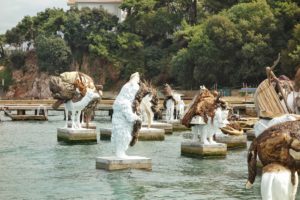
Andrew Yang answers:
Your work takes influences from how we experience our surroundings. How has your personal experience with Istanbul and its metamorphic nature affected the creation span of IO-OX?
An important part of my experience in visiting Istanbul was the variety of sounds across the city. The soundscape in the installation in the Galata School includes my own recording of the sounds riding a ferry up the Bosphorus as well as the noise of workers hammering the cymbals in the Istanbul Agop factory. For the cymbals, I really liked the idea of the sounds that happen when making a instrument of sound: the craftsmen hit the cymbal not to make noise, but to make the cymbal an instrument able to make specific kinds of noise. In that way the sound of banging in the cymbal factory is the “sound of sound being made.” I wanted people in the installation to then have a chance to hit the cymbals themselves and make their own kind of music in collaboration with the cymbal craftsmen who actually made the cymbals (together with the sounds of the moon Io and the dolphins in the Bosphorus that are also include in the ambient composition playing in the room.) You can listen to that “noise bathing” soundtrack here.
The title and the context of 14th Istanbul Biennale, “Salt Water”, has also come to signify a political issue that is a global and visible human tragedy, especially in the last few months. The refugees trying to escape the war in Syria have been forced to risk their lives on a journey on Mediterranean waters to safety and freedom. The refugee crisis have created a shift in our perception of what salt water means for the unfortunate victims of war. Do you think this recently highlighted global issue creates a need and/or an chance for a reactionary response from the Biennale and the contributing artists? If so, what kind of possibilities do you see?
The refugee crisis has been acute throughout all of 2015, and so I think the biennial artists were already aware of the crisis and made their own choices as to how to reflect and respond to it, if at all. Carolyn Christov-Bakargiev recently said “through art, we mourn, commemorate, denounce, try to heal and we commit ourselves to the possibility of joy and vitality, leaping from form to flourishing life.” I think that some artists explored the current crisis though historical displacements (of Armenians, Greeks) while other artists might have had much more subtle or personal ways to react to current events. In my project the theme of “voyagers” was chosen in large part because of the migration crisis now, although it is not an overt part of the work. I took interest in the myth of Io because she was refugee of violence, and likewise took interest in the dolphins of the Bosphorus who are marginalized migrants among all the human ship traffic and fishing – “street children of the Bosphorus” is what the marine biologist call them. Io and the dolphins are different manifestations of thinking through larger issues, but obviously they don’t address the urgent political one of the refugees themselves. I also think some artists simply feel the particular art that they make isn’t the medium to respond to these kinds of issues, seeing other means of taking action in their own lives as having more impact. Perhaps this is especially true in the context of large art events like biennials and the spectacle that surrounds them?
Just as “saltwater” is both materially and metaphorically charged by the refugee crisis, so are “waves” – another key theme of the biennial. Almost all of the reports by the world press right now use waves, water, and fluidity as metaphors for the current mass migrations. In an essay for the biennial catalog I wrote:
“A wave is a disturbance; waves are utterly disturbing, from centre to edge….The saltwater is everywhere. The ‘medi-’ in medium means ‘middle’, and the Medi-terrean is a sea in the middle of the earth, now thoroughly desperate with waves of displacement, a medium promising refuge from endless instability ((explosions, hollowing out, sonic booms), yet so many resonating vessels have been lost to that boundary water. Middle east has become north, west and south with living waves looking for ground that doesn’t shake; they can rely on nothing but their own tenacious momentum through a constant crash of waves.” (You can read the whole essay in Turkish here)
In the end I think we all feel at a loss for how exactly to respond meaningfully, especially those of us who are further from the direct effects of the crisis…
